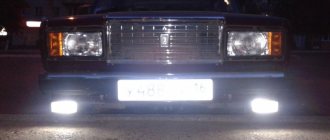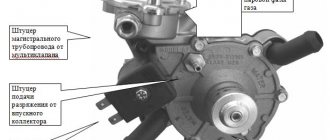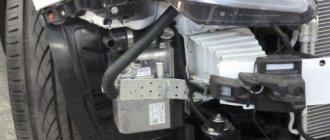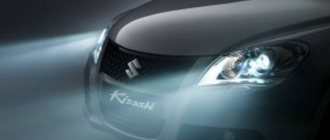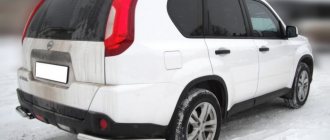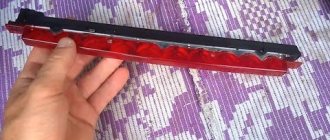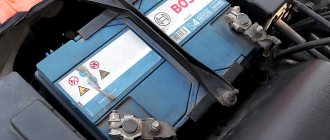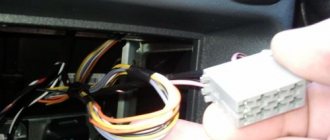07/18/2021 7,366 Auxiliary systems
Author: Ivan Baranov
Parktronic is a device designed to help motorists park a vehicle. Drivers, as they say, are divided into two types - those who never recognize such a device and those who simply cannot park without it. So how is it installed, what do you need to know about the parking sensor operation scheme - read about it below.
[Hide]
Operating principle and types of parking sensors
The principle of operation of the parking sensors is that the electronic unit processes signals received from wireless transceiver sensors installed on the car’s bumper and presents them on the display in a form convenient for the driver.
In the simplest parking sensors, the information is an intermittent sound signal, the frequency of which increases as the vehicle approaches an obstacle.
In the most common parking sensors, information with an audible signal is supplemented by a monitor or display, on which the distance to the obstacle in meters is displayed in graphical or graphical and digital form. You can see the structural wiring diagram of such a radar in the photograph. Expensive models of parking sensors additionally have a video camera, the lens of which constantly has to be wiped clean of dirt, which in practice negates all its advantages.
Distance measurement sensors in parking sensors are used in two types - tape and ultrasonic. Tape sensors are a metal strip attached to the inside of the bumper; they detect an obstacle only at a distance of less than 30 cm and do not work well in a wet environment, so they are practically not used.
There are types of wireless parking radars in which the signal from the electronic unit to the monitor is transmitted using a radio signal. The price of such parking sensors is an order of magnitude higher, and the apparent ease of installation is deceptive, since it is still necessary to supply the supply voltage to the devices using wires, which practically negates the advertised advantage. In addition, such a system is susceptible to radio interference, which reduces the stability of the parking radar as a whole. I immediately refused to buy such parking sensors.
Design and principle of operation of an ultrasonic parking sensor
Ultrasonic parking sensors are unpretentious and can confidently detect any obstacle located at a distance from the car closer than 2 meters. The ultrasonic sensor is similar to a telephone headset, only the speaker and microphone are installed in the same housing.
The sensor works as follows. A burst of pulses with a frequency of 40 kHz is periodically supplied from the electronic unit to the sensor emitter. If an obstacle is encountered along the path of the pulse, it is reflected and picked up by the microphone. It is then transmitted to an electronic signal processing unit, which measures the time interval between the moment the pulse is emitted and the time it returns from the obstacle. The further away the obstacle is, the longer it takes for the signal to return to the sensor. The distance is determined in this simple way. The electronic unit can only convert the travel time of the pulse into meters and display the information on the display.
The distance at which the parking sensor can detect an obstacle depends on the power of the emitted pulse and the sensitivity of the microphone.
The angle of radiation of the pulses is limited, therefore, to completely cover the blind spot, at least four ultrasonic sensors must be installed on the bumper.
Connection with activation button
This scheme is extremely simple, and it works quite conveniently and effectively. But there is one drawback - you will have to start the parking sensors manually. The diagram requires a button. It is installed in any place convenient for the driver.
Power for the system is taken from the same place where the recorder or lampshade is powered. The connection principle is simple - when the motor is running, power is supplied to it. If you turn off the engine, then the parking sensors will turn off. Naturally, such a connection is far from ideal - according to the rules, the device should start automatically if the vehicle speed is 20 kilometers per hour or lower.
Which parking sensor to choose and where is it cheaper to buy?
When the car moves forward, all obstacles are clearly visible, so there is no point in installing parking sensors on the front bumper. Based on the above, for self-installation in my car, I chose parking sensors with four ultrasonic sensors for installation on the rear bumper, with a sound alert and display of graphic and digital information on the display.
After determining the radar configuration that satisfied my requirements and searching for parking sensors on the Internet, I found one that was suitable for price and quality in the Chinese online store AliExpress. As a result, taking into account self-installation and the cost of materials, my costs for installing parking sensors in the car amounted to a little more than $11.
The photo shows a set of components for installing parking sensors in a car. The kit even includes a special cutter for drilling holes in the bumper for installing ultrasonic parking sensors.
Checking the parking sensors before installing them in the car
Before installing parking sensors in a car, to avoid surprises, it is necessary to check its functionality. To do this, you need, in accordance with the above block diagram, to connect all sensors and a display to the electronic control unit and apply +12 VDC supply voltage to it, observing the polarity, from a power supply designed for a current of at least 0.3 A or a battery. It is impossible to make a mistake here, since all the connectors are different, with the exception of the connectors for connecting parking sensors. But when checking, the order in which the sensors are connected does not matter, since they are interchangeable.
If the sensors are left lying on the table, then it will be impossible to check the parking sensors in operation. Therefore, you need to simulate their installation on a car bumper. To do this, you need to drill four holes in a sheet of corrugated cardboard or any other sheet material using the cutter from the kit and install ultrasonic sensors in them, as shown in the photo. The distance between the holes should be more than 10 cm.
Next, direct the sheet with sensors into a space two meters free from obstacles and turn on the parking sensors. All that remains to check is to walk in front of the sensors and see what is displayed on the monitor. If everything works, then you can begin installing the radar in the car body.
For interest and to evaluate the quality of the parking sensors, I opened the control unit, its printed circuit board is in the photo. The presence of markings of elements, neat installation, high quality soldering and voltage reserve of electrolytic capacitors pleased us.
Possible problems
Most parking sensors are activated when reverse gear is activated. After this, the picture immediately appears on the monitor screen. Thus, the device does not need a button to turn on.
Sometimes after installing the device, the video is not displayed on the display. In rare cases, strange signals may be observed. There are several types of problems that need to be corrected immediately when problems are detected.
These include:
The danger signal does not turn off. This indicates that a short circuit has occurred in the system, or the sensor is “blocked” by an unknown substance. It happens that dirt or snow sticks to them. Sometimes, when water gets in, the sensor starts to act up, which makes the driver even more nervous. That is why the first step is to check for foreign objects. After making sure that they are absent, the owner must do the wiring.
The device does not indicate an approaching obstacle, although there really is one. Perhaps the sensor has broken down altogether, or the entire system has failed. First, the driver needs to check the sensor by hand, and then decide whether to change only it or the entire system.
The device produces a “violent” reaction to minor obstacles. It happens that the driver parks in the grass, and the device does its best to signal a collision. This happens if the gadget has hypersensitivity set in its settings.
If the device initially worked normally, and then began to act up, then the problem is most likely in the wiring. From time to time, its contacts come off, or the protective shell wears off. In case of such breakdowns, you can fix everything yourself. You will have to replace the device with a new one if the control unit fails.
Choosing a location for installing the monitor and electronic parking sensors
When parking in reverse, the driver usually looks at the side mirrors and rearview mirror. Taking the parking sensor monitor in my hands and sitting in the driver’s seat of the car, I began to look for the most rational place to install it. As a result, taking into account the need to lay wires to the electronic unit, it was decided to mount the monitor on top of the rear view mirror.
Ultrasonic parking sensors are installed in the rear bumper, and the supply voltage is most easily supplied from the reversing light, since the parking sensors should only work when reverse gear is engaged. Therefore, it was decided to install the electronic unit in close proximity to the sensors - in the luggage compartment.
As a result, the wiring diagram of the ultrasonic parking radar shown in the photograph was created. Now all the questions regarding the installation of parking sensors have been worked out and you can begin installing it in the car.
Each ultrasonic parking sensor, depending on its installation location on the bumper, must be connected to its own connector on the electronic unit. Therefore, the connectors must be marked in advance in accordance with the inscriptions on the body of the electronic unit.
Is he needed?
Often, owners of cars with rear parking sensors are faced with a dilemma: is a similar sensor needed at the front. This applies more to beginners who find it difficult to park their car using parking sensors. But not installing such an important system is a mistake.
Its presence reduces the likelihood of major and minor collisions, from damage to the bumper on a curb stone to an accident.
If the car has high ground clearance, radars are not necessary. But with low ground clearance they are irreplaceable.
Instructions for installing parking sensors on a car with your own hands
The technology for installing radar on cars of different manufacturers and models is not much different, and therefore the instructions given for self-installation of parking sensors using the example of a Hyundai Getz car will be useful to the owner of any car.
Laying the wire from the monitor to the electronic unit
It was decided to stretch the cable from the monitor to the electronic parking sensor unit between the ceiling trim and the roof of the car. This is the shortest route and does not require removal of the casing.
The ceiling trim near the rear-view mirror was moved down a couple of centimeters and a piece of foam plastic was inserted into the resulting gap for ease of work.
At the ceiling of the trunk door, the trim was freed from the rubber seal and also moved down a couple of centimeters. Next, an attempt was made to stretch a steel wire with a diameter of about two millimeters through the resulting gaps from the trunk to the rear-view mirror. But, unfortunately, the wire rested on something and despite numerous attempts it was not possible to thread it through.
I solved the problem by pulling the wire in several stages. First, from the rearview mirror into the gap that I made by freeing the headliner at the top of the driver's door from the rubber seal, then through the second gap at the left rear door and then through the gap in the trunk. The rope was first stretched using wire.
To prevent damage to the monitor connector, it was attached to a rope using electrical tape, as in the photo. All that remains is to carefully pull the rope and the wire will easily pass behind the trim to the trunk. I completed this job in a parking lot in the yard of the house in 15 minutes.
Removing plastic panels
To conceal the wiring from the ultrasonic sensors and supply power to the electronic unit, it is necessary to free the left side of the trunk from the plastic panel.
The first step is to recline the rear seats and remove the trunk floor covering. It is secured with several screws and clips. Can be removed without difficulty.
Next you need to remove the plastic panel on the rear wall of the trunk. To do this, all visible screws and bolts are unscrewed, and the panel moves upward with considerable force. It is held on by four clips and can be removed easily.
To begin installing the parking sensors, all that remains is to remove the left side panel of the trunk. Again you need to unscrew all visible screws. Next, from the left door side, pull it away from the car body and when the two clips are released, pull the panel towards you.
Installing ultrasonic parking sensors on the bumper
Radar manufacturers recommend installing rear parking sensors at a height of 50-70 mm from the road surface. Thus, the sensors could be installed on the black molding or on the top of the bumper. I chose the second option.
The photo shows a drawing with recommended installation dimensions for radar sensors. Depending on the width of the car, the dimensions need to be adjusted.
Since the diameter of the sensors was 22 mm, a 40 mm indent was made from the top line of the bumper. The drill hole centers were marked directly on the bumper surfaces using an alcohol marker.
Since the end mill had a drill bit in the center, it was easy to accurately drill the holes using an electric drill. The edges of the holes turned out neat, without burrs. You can also use a cordless screwdriver for drilling.
There was a hole in the rear wall of the trunk through which the wire from the rear fog lamp passed. It was decided to lay wires from the ultrasonic sensors through it. The rubber o-ring was removed and a rope was pulled through the drilled hole next to the fog light using a steel wire.
Next, the wire was threaded through the hole for installing the outermost sensor into the hole for installing the central sensor, and then the rope was pulled.
The sensor connector was attached to the rope using insulating tape, as shown in the photo, and the wire was pulled through it into the trunk. Pulling should be done effortlessly so as not to damage the wires and sensor connectors.
To prevent the sensor wires from rubbing against the steel edges of the car body and to seal it, a slot was made in the sealing ring with a knife through which the wires were threaded. Next, the seal was installed in place.
When installing sensors in the bumper, they must be oriented so that the arrow on their housings points upward.
An attempt to mount the ultrasonic sensor in the bumper was unsuccessful the first time. The sensor did not want to hold on. It turned out that the silicone clips were designed for mounting on a thin wall, and the thickness of the bumper was 2.5 mm. I had to use a knife to remove part of each clamp so that the gap between them and the sensor flange was 2.5 mm. After modification, the sensors were firmly fixed. It was impossible to pull them out with a fingernail. Therefore, no glue was needed.
After attaching the ultrasonic rear sensors to the car's bumper, the wires coming from them were tied together using plastic clamps with the wires coming from the fog lamp.

